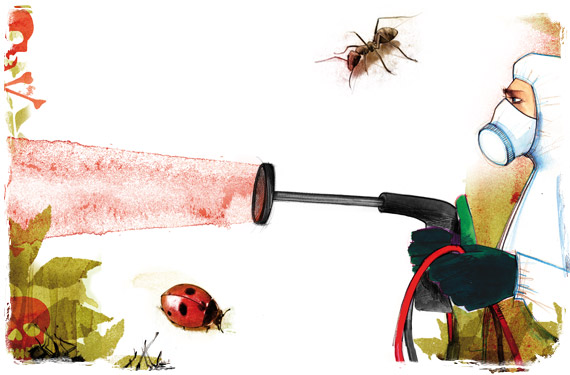Eco Bed Bug Exterminators Dc Things To Know Before You Buy
Eco Bed Bug Exterminators Dc Things To Know Before You Buy
Blog Article
Eco Bed Bug Exterminators Dc Fundamentals Explained
Table of ContentsThe Greatest Guide To Eco Bed Bug Exterminators DcThe 6-Minute Rule for Eco Bed Bug Exterminators DcMore About Eco Bed Bug Exterminators DcThe 10-Minute Rule for Eco Bed Bug Exterminators DcThe Ultimate Guide To Eco Bed Bug Exterminators Dc
Because chemicals are toxic, they are also potentially hazardous to humans, animals, various other microorganisms, and the setting. Consequently, individuals that make use of pesticides or consistently come in call with them must understand the relative toxicity, potential wellness impacts, and preventative steps to minimize exposure to the products they use. Risk, or threat, of using chemicals is the capacity for injury, or the degree of danger included in utilizing a pesticide under a provided collection of problems..png)
Applicators can reduce or nearly remove direct exposure-- and hence minimize danger-- by adhering to the tag instructions, making use of individual safety clothing and devices (PPE), and managing the chemical effectively. For instance, even more than 95 percent of all pesticide exposures come from facial exposure, primarily to the hands and forearms. By putting on a pair of unlined, chemical-resistant handwear covers, this kind of direct exposure can be almost eliminated.
The dangerous impacts that happen from a solitary direct exposure by any course of entry are labelled "severe impacts." The four paths of direct exposure are facial (skin), inhalation (lungs), dental (mouth), and the eyes. Intense toxicity is determined by analyzing the facial toxicity, inhalation toxicity, and dental poisoning of examination animals.
How Eco Bed Bug Exterminators Dc can Save You Time, Stress, and Money.
Intense toxicity is determined as the amount or focus of a toxicant-- the a.i.-- required to eliminate 50 percent of the pets in a test populace. This step is generally revealed as the LD50 (lethal dosage 50) or the LC50 (lethal focus 50). Furthermore, the LD50 and LC50 worths are based upon a solitary dosage and are videotaped in milligrams of pesticide per kilogram of body weight (mg/kg) of the guinea pig or in parts per million (ppm).
The lower the LD50 or LC50 value of a chemical product, the higher its toxicity to people and animals. Chemicals with a high LD50 are the least poisonous to people if made use of according to the instructions on the item label. The chronic toxicity of a chemical is established by subjecting guinea pig to lasting direct exposure to the energetic ingredient.
The chronic toxicity of a pesticide is more challenging than severe toxicity to identify through laboratory evaluation. Products are classified on the basis of their loved one intense toxicity (their LD50 or LC50 values). Pesticides that are categorized as highly toxic (Poisoning Category I) on the basis of either dental, facial, or inhalation poisoning should have the signal words DANGER and toxin printed in red with a skull and crossbones icon prominently showed on the front panel of the package label.
The intense (single dose) oral LD50 for chemical items in this group varies from a trace total up to 50 mg/kg. For example, exposure of a couple of drops of a product taken by mouth could be deadly to a 150-pound individual. Some pesticide products have simply the signal word threat, which tells you absolutely nothing concerning the acute poisoning, just that the product can create serious eye damage or severe skin inflammation
The 2-Minute Rule for Eco Bed Bug Exterminators Dc
In this classification, the intense oral LD50 varieties from 50 to 500 mg/kg. A tsp to an ounce of this material might navigate here be deadly to a 150-pound person (exterminator near me). Chemical items identified as either slightly harmful or fairly nontoxic (Toxicity Classifications III and IV) are needed to have the signal word CAUTION on the chemical tag

All pesticide toxicity worths, including the LD50, can be located on the product's Material Safety and security Data Sheet (MSDS) - how to get rid of bed bugs. Pesticide tags and MSDS can be gotten from stores or manufactures. On top of that, the majority of items also know that can be located on the Internet. The signs of chemical poisoning can range from a moderate skin inflammation to coma or even death.
Because of prospective health worries, chemical individuals and trainers need to recognize the common indications and symptoms of chemical poisoning. The effects, or signs and symptoms, of pesticide poisoning can be generally defined as either topical or systemic.
Fascination About Eco Bed Bug Exterminators Dc
Dermatitis, or swelling of the skin, is approved as the most commonly reported topical result linked with chemical direct exposure. Some people often tend to cough, hiss, or sneeze when revealed to chemical sprays.
This symptom generally subsides within a couple of minutes after an individual is eliminated from the exposure to the irritant. Nonetheless, a response to a chemical product that creates a person not only to sneeze and cough but also to create extreme acute respiratory system signs is more probable to be a real hypersensitivity or allergy.
Systemic effects are rather different from topical results. They frequently occur far from the initial point of contact as an outcome of the pesticide being absorbed right into and dispersed throughout the body. Systemic effects frequently include nausea or vomiting, throwing up, tiredness, frustration, and intestinal tract conditions. In advanced poisoning situations, the person may experience adjustments in heart rate, trouble breathing, convulsions, and coma, which might bring about fatality.
Report this page